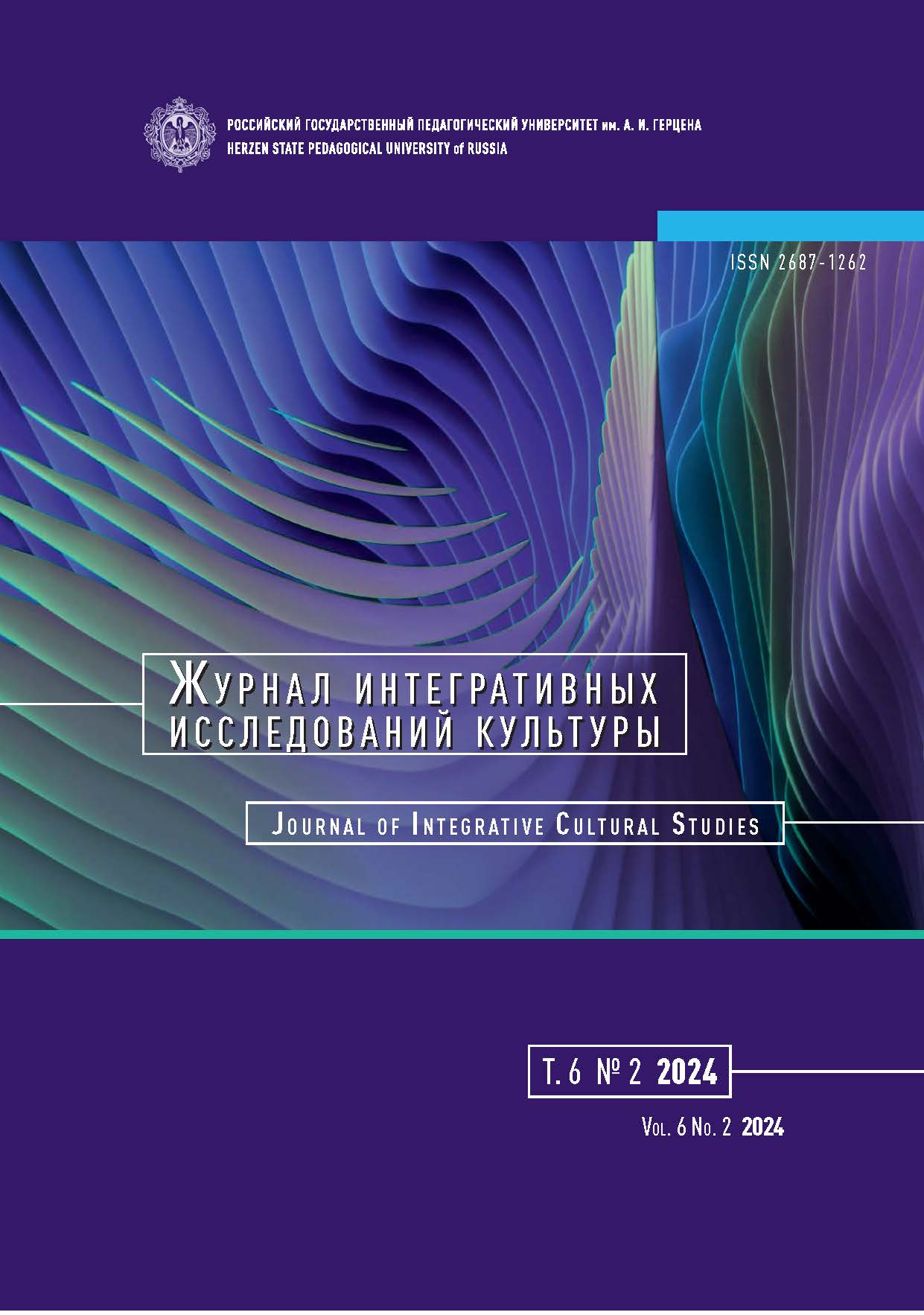Paul Celan: Poetic creativity in the light of the philosophy of dialogue
DOI:
https://doi.org/10.33910/2687-1262-2024-6-2-117-129Keywords:
Paul Celan, philosophy of dialogue, Martin Buber, Emmanuel Lévinas, German literature, poetic subject, poetologyAbstract
The concept of the lyrical work as a monologue of the poetic subject originated in the 18th century. However, this established understanding of lyricism proved insufficient for discussions of the 20th century poetry, which reflected the century’s crises and catastrophes that questioned all the foundations of humanity. Accordingly, the traditional anthropomorphic poetic subject that mirrors the outline of a person also began to transform. Scholars are still in the process of transitioning to new models of interpretation that consider a poem as an interaction of poetic voices. Paul Celan (1920–1970) was one of the poets whose poetological ideas contradicted the established definition of lyricism. Celan insisted on the necessity of dialogue and, more broadly, polyphony in a poem: he argued that a poem is directed towards the Other and thus overcomes the totality of monologue. Celan’s reflections on poetry followed the philosophy of dialogue, particularly the works of Martin Buber (1878–1965). Combining the traditions of European philosophy and Judaism, Buber contrasted the idealistic absolute I with a subject that exists solely as part of the relations I—It or I—Thou. After World War II, the philosophy of dialogue was further developed by Emmanuel Lévinas (1905–1995). According to Lévinas, the fundamental correlation between I and the Other frees the subject from the claim to total domination and preserves the plurality of personalities that do not dissolve under the unifying light of Reason.
References
ИСТОЧНИКИ
Бюхнер, Г. (1935) Сочинения. М.; Ленинград: Academia, 400 с.
Целан, П. (2013) Стихотворения. Проза. Письма. М.: Ad Marginem, 736 с.
Celan, P. (2018) Die Gedichte: Neue kommentierte Gesamtausgabe. Mit den zugehörigen Radierungen von Gisèle Celan-Lestrange. Berlin: Suhrkamp Publ., 1262 p.
Celan, P. (2000) Gesammelte Werke in sieben Bänden. Bd. III. Gedichte III. Prosa. Reden. Frankfurt am Main: Suhrkamp Publ., 233 p.
ЛИТЕРАТУРА
Агамбен, Д. (2012) Homo sacer. Что остается после Освенцима: архив и свидетель. М: Европа, 192 с.
Беневич, Г. (1998) Слово о Левинасе. В кн.: Время и другой. СПб.: Высшая Религиозно-Философская Школа, с. 10–17.
Беньямин, В. (2004) Шарль Бодлер. Поэт в эпоху зрелого капитализма. В кн.: Беньямин, В.; Белобратов, А. В. (ред.) Маски времени. Эссе о культуре и литературе. СПб.: Симпозиум, с. 47–234.
Бубер, М. (1995) Я и Ты. В кн.: Два образа веры. М.: Республика, с. 15–92.
Бубер, М. (2008) Изреченное слово. Личность. Культура. Общество, т. 10, № 2 (41), с. 19–26.
Гадамер, Х.-Г. (1988) Истина и метод. Основы философской герменевтики. М.: Прогресс, 705 с.
Гадамер, Х.-Г. (2013) Феноменологический и семантический подход к Целану? Horizon. Феноменологические исследования, т. 2, № 2, с. 96–105.
Гегель, Г. (1971) Эстетика: в 3 т. Т. 3. М.: Искусство, 621 с.
Евстропов, М. Н. (2010) Эмманюэль Левинас: «лицо» как абсолютное выражение. Известия Томского политехнического университета, т. 317, № 6, с. 101–106.
Каминская, Ю. В. (2023) Поэзия и интерпретация. YouTube. [Электронный ресурс]. URL: https://www.youtube.com/playlist?list=PLcsjsqLLSfNBg2GjaajzqyYQSEi_LdwpV (дата обращения 22.10.2023).
Коноваленко, М. (2022) Мандельштам и Баобаб (Etwas Ungereimtes: Об одной маленькой целановской нелепости). Новое литературное обозрение, № 173, с. 191–197.
Лаку-Лабарт, Ф. (2015) Поэзия как опыт. О творчестве Пауля Целана. М.: Три квадрата, 192 с.
Левинас, Э. (1998) Время и другой. В кн.: Время и другой. СПб.: Высшая Религиозно-Философская Школа, с. 21–119.
Левинас, Э. (2000) Тотальность и бесконечное. В кн.: Избранное. Тотальность и бесконечное. М.; СПб.: Университетская книга, с. 66–291.
Померанц, Г. С. (1995) Встречи с Бубером. В кн.: Два образа веры. М.: Республика, с. 3–14.
Bücher, R. (1987) Erfahrenes Sprechen — Leseversuch an Celan-Entwürfen. In: A. D. Colin (ed.). Argumentum e Silentio. International Paul Celan Symposium. Berlin; New York: De Gruyter Publ., pp. 99–112. https://doi.org/10.1515/9783110850109.99
Fußl, I. (2007) Jewish history and memory in Paul Celan’s “DU LIEGST”. Studies in 20th & 21st Century Literature, vol. 31, no. 1, article 8. https://doi.org/10.4148/2334-4415.1648
Gadamer, H.-G. (1989) Wer bin Ich und wer bist Du? Kommentar zu Celans „Atemkristall“. Frankfurt am Main: Suhrkamp Publ., 155 p.
Gellhaus, A. (1995) Enthusiasmos und Kalkül. Reflexionen über den Ursprung der Dichtung. München: Fink Publ., 390 p.
Girbig, A. (2004) “Die Abgründe sind / eingeschworen auf Weiß.” Erinnerung und Dialog. Bemerkungen zum Motiv des Schnees in Gedichten Paul Celans. Cahiers d’Études Germaniques, vol. 47, no. 2, pp. 123–136.
Goltschnigg, D. (2012) Das “Gegenwort” — Georg Büchner. In: M. May, P. Goßens, J. Lehmann (eds.). Celan Handbuch. Leben—Werk—Wirkung. Stuttgart; Weimer: Verlag J. B. Metzler, pp. 304–308.
Im Sommer, durch den Sommer: Statistical comparison 1800–2019. (2019) Google Books Ngram Viewer. [Online]. Available at: https://books.google.com/ngrams/graph?content=im+Sommer%2C+durch+den+Sommer&year_start=1800&year_end=2019&corpus=de-2019&smoothing=3 (accessed 01.08.2023).
Joris, P. (2014) Commentary. In: Breathturn into timestead: The collected later poetry: A bilingual edition. New York: Farrar, Straus and Giroux Publ., pp. 459–628.
Keiling, T. (2011) Ort und Zeit im Meridian. Heidegger in Derridas Celan-Interpretation. In: D. Espinet (ed.). Schreiben. Dichten. Denken. Zu Heideggers Sprachbegriff. Frankfurt am Main.: Vittorio Klostermann Publ., pp. 177–195.
Lyon, J. K. (1971) Paul Celan and Martin Buber: Poetry as Dialogue. Publications of the Modern Language Associatin of America, vol. 86, no. 1, pp. 110–120. https://doi.org/10.2307/461008
May, M. (2012) Atemwende. In: M. May, P. Goßens, J. Lehmann (eds.). Celan Handbuch. Leben—Werk—Wirkung. Stuttgart; Weimer: Verlag J. B. Metzler, pp. 89–98.
Maslon, S. (2012) Stating the Obvious: Celan—Beckett—Nauman. Katowice: Wydawnictwo Uniwersytetu Śląskiego Publ., 123 p.
Peters, P. (1994) Geschwindigkeiten des Wortes: Tracing Celan’s Metaphor. Seminar: A Journal of Germanic Studies, vol. 30, no. 2, pp. 127–136.
Piszczatowski, P. (2016) In den Flüssen nördlich der Zukunft—Nordische Landschaften in Gedichten von Paul Celan. In: M. Tarvas, F. H. Marten, A. Johanning-Radžienė et al. (eds.). Triangulum. Germanistisches Jahrbuch 2015 für Estland, Lettland und Litauen. Vilnius: Vilnius Academy of Fine Arts Press, 606 p.
Poetry in Transition 2019–2022. (2022) [Online]. Available at: https://lyrik-in-transition.uni-trier.de/?lang=en (accessed 07.10.2023).
Rychlo, P. (2022) Stationen poetischer Entwicklung: Paul Celans Gedichtbände in chronologisch-historischer Folge. Göttingen: V&R Unipress, 131 p.
Schmid, J. K. (2023) Pharmazeutische Aspekte von Morus alba. Diplomarbeit zur Erlangung des akademischen Grades einer Magistra der Pharmazie. Graz: Karl-Franzens-Universität Graz Publ., 55 p.
Schmitzer, U. (2017) Pyramus der Narr — Christus Pyramus. Ovid malt die Sage von Pyramus und Thisbe. Gymnasium, no. 124, pp. 529–560. https://doi.org/10.11588/propylaeumdok.00004814
Seiderer, U. (2002) Körper unter Wasser. Die illegitime Geste der Fiktion—Flussleichen des 20. Jahrhunderts: Georg Heym, Paul Celan, Peter Szondi. Recherches Germaniques, no. 32, pp. 145–185.
Stahl, H. (2016) Gedichte schreiben in Zeiten der Umbrüche. Tendenzen der Lyrik seit 1989 in Russland und Deutschland. Leipzig: BiblionMedia Publ., 676 p.
Tucker, B. (2013) Rebuke: From trope to event in Paul Celan’s “Zähle die Mandeln”. The German Quarterly, vol. 86, no. 3, pp. 257–274.
Waldenfels, B. (2004) Levinas and the face of the other. In: S. Critchley, R. Bernasconi (eds.). The Cambridge Companion to Levinas. Cambridge: Cambridge University Press, pp. 63–81.
Wögerbauer, W. (2017) Anmerkungen zur Stigmatisierung des Privaten in der Celan-Forschung. Geschichte der Germanistik. Historische Zeitschrift für die Philologien, no. 51–52, pp. 5–15.
Yang, Y. (2017) Durch einen Gestuswandel gestaltgewordene Sprache: Celan-Studie mit einer Fokussierung auf den Atemwende-Gedichtband. PhD dissertation (Philosophy). Aachen, Westfälischen Technischen Hochschule Aachen, 225 p.
SOURCES
Büchner, G. (1935). Sochineniya [Collected Works]. Moscow; Leningrad: Academia Publ., 400 p. (In Russian)
Celan, P. (2018) Die Gedichte. Neue kommentierte Gesamtausgabe. Mit den zugehörigen Radierungen von Gisèle Celan-Lestrange [The poems. New annotated complete edition. With the associated etchings by Gisèle Celan- Lestrange]. Berlin: Suhrkamp Publ., 1262 p. (In German)
Celan, P. (2000) Gesammelte Werke in sieben Bänden. Bd. III. Gedichte III. Prosa. Reden [Collected works in seven volumes. Vol. III. Poems III. Prose. Talk]. Frankfurt am Main: Suhrkamp Publ., 233 p. (In German)
Celan, P. (2013) Stikhotvoreniya. Proza. Pis’ma [Poems. Prose. Letters]. Moscow: Ad Marginem Publ., 736 p. (In Russian)
REFERENCES
Agamben, G. (2012) Homo Sacer. Chto ostaetsya posle Osventsima: arkhiv i svidetel’ [Homo Sacer. Quel Che Resta di Auschwitz: L’archivio e il Testimone]. Moscow: Evropa Publ., 192 p. (In Russian)
Benevich, G. (1998) Slovo o Levinase [A word about Lévinas]. In: Vremya i drugoj [Le Temps et L’autre]. Saint Petersburg: Saint Petersburg School of Religion and Philosophy Publ., pp. 10–17. (In Russian)
Benjamin, W. (2004) Sharl’ Bodler. Poet v epokhu zrelogo kapitalizma [Charles Baudelaire: A Lyric Poet in the Era of High Capitalism]. In: Maski vremeni. Esse o kul’turei literature [Masks of Time: Essays on culture and literature]. Saint Petersburg: Symposium Publ., pp. 47–234. (In Russian)
Buber, M. (1995) Ya i Ty [Me and You]. In: Dva obraza very [Two Images of Faith]. Moscow: Respublika Publ., pp. 15–92. (In Russian)
Buber, M. (2008) Izrechennoe slovo [The word, has been uttered]. Lichnost’. Kul’tura. Obshchestvo — Personality. Culture, Society, vol. 10, no. 2 (41), pp. 19–26. (In Russian)
Bücher, R. (1987) Erfahrenes Sprechen — Leseversuch an Celan-Entwürfen. In: A. D. Colin (ed.). Argumentum e Silentio. International Paul Celan Symposium. Berlin; New York: De Gruyter Publ., pp. 99–112. https://doi.org/10.1515/9783110850109.99 (In German)
Evstropov, M. N. (2010) Emmanyuel’ Levinas: “litso” kak absolyutnoe vyrazhenie [Emmanuel Lévinas: “Face” as absolute expression]. Izvestiya Tomskogo politekhnicheskogo universiteta — Bulletin of the Tomsk Polytechnic University, vol. 317, no. 6, pp. 101–106. (In Russian)
Fußl, I. (2007) Jewish history and memory in Paul Celan’s “DU LIEGST”. Studies in 20th & 21st Century Literature, vol. 31, no. 1, article 8. https://doi.org/10.4148/2334-4415.1648 (In English)
Gadamer, H.-G. (1988) Istina i metod. Osnovy filosofskoj germenevtiki [Truth and Method. Fundamentals of Philosophical Hermeneutics]. Moscow: Progress Publ., 705 p. (In Russian)
Gadamer, H.-G. (1989) Wer bin Ich und wer bist Du? Kommentar zu Celans „Atemkristall“ [Who am I and who are you? Commentary on Celan’s “Breathing Crystal”]. Frankfurt am Main: Suhrkamp Publ., 155 p. (In German)
Gadamer, H.-G. (2013) Fenomenologicheskij i semanticheskij podkhod k Tselanu? [Phenomenological and semantic approaches to Paul Celan?] Horizon. Fenomenologicheskie issledovaniya — Horizon. Studies in Phenomology, vol. 2, no. 2, pp. 96–105. (In Russian)
Gellhaus, A. (1995) Enthusiasmos und Kalkül. Reflexionen über den Ursprung der Dichtung [Enthusiasm and calculation. Reflections on the origins of poetry]. München: Fink Publ., 390 p. (In German)
Girbig, A. (2004) “Die Abgründe sind / eingeschworen auf Weiß.” Erinnerung und Dialog. Bemerkungen zum Motiv des Schnees in Gedichten Paul Celans [“The abysses are / sworn to white.” Memory and dialogue. Comments on the motif of snow in Paul Celan’s poems]. Cahiers d’Études Germaniques, vol. 47, no. 2, pp. 123–136. (In German)
Goltschnigg, D. (2012) Das “Gegenwort” — Georg Büchner [The “Counterword” — Georg Büchner]. In: M. May, P. Goßens, J. Lehmann (eds.). Celan Handbuch. Leben—Werk—Wirkung [Celan manual. Life—Work—Effect]. Stuttgart; Weimer: Verlag J. B. Metzler, pp. 304–308. (In German)
Hegel, G. (1971) Estetika: v 3 t. T. 3 [Aesthetics: In 3 Vols. Vol. 3]. Moscow: Iskusstvo Publ., 621 p. (In Russian)
Im Sommer, durch den Sommer: Statistical comparison 1800–2019. (2019) Google Books Ngram Viewer. [Online]. Available at: https://books.google.com/ngrams/graph?content=im+Sommer%2C+durch+den+Sommer&year_start=1800&year_end=2019&corpus=de-2019&smoothing=3 (accessed 01.08.2023). (In English)
Joris, P. (2014) Commentary. In: Breathturn into timestead: The collected later poetry: A bilingual edition. New York: Farrar, Straus and Giroux Publ., pp. 459–628. (In English)
Kaminskaya, Yu. V (2023). Poeziya i interpretatsiya [Poetry and interpretation]. YouTube. [Online]. Available at: https://www.youtube.com/playlist?list=PLcsjsqLLSfNBg2GjaajzqyYQSEi_LdwpV (accessed 22.10.2023). (In Russian)
Keiling, T. (2011) Ort und Zeit im Meridian. Heidegger in Derridas Celan-Interpretation [Place and time in the meridian. Heidegger in Derrida’s interpretation of Celan]. In: D. Espinet (ed.). Schreiben. Dichten. Denken. Zu Heideggers Sprachbegriff [Write. Dense. Think. On Heidegger’s concept of language]. Frankfurt am Main.: Vittorio Klostermann Publ., pp. 177–195. (In German)
Konovalenko, M. (2022) Mandel‘shtam i Baobab (Etwas Ungereimtes: Ob odnoj malen’koj tselanovskoj neleposti) [Mandelstam and the Baobab (Etwas Ungereimtes: On one small celan absurdity)]. Novoe literaturnoe obozrenie — New Literary Observer, no. 173, pp. 191–197. (In Russian)
Lacoue-Labarthe, P. (2015) Poeziya kak opyt. O tvorchestve Paulya Tselana [Poetry as Experience: On the Work of Paul Celan]. Moscow: Tri kvadrata Publ., 192 p. (In Russian)
Lévinas, E. (1998) Vremya i drugoj [Le Temps et L’autre]. In: Vremya i drugoj [Le Temps et L’autre]. Saint Petersburg: Saint Petersburg School of Religion and Philosophy Publ., pp. 21–119 (In Russian)
Lévinas, E. (2000) Total’nost’ i beskonechnoe [Totality and Infinity: An Essay on Exteriority]. In: Izbrannoe. Total’nost’ I beskonechnoe [Selected Works. Totality and Infinity]. Moscow; Saint Petersburg: Universitetskaya kniga Publ., pp. 66–291. (In Russian)
Lyon, J. K. (1971) Paul Celan and Martin Buber: Poetry as Dialogue. Publications of the Modern Language Associatin of America, vol. 86, no. 1, pp. 110–120. https://doi.org/10.2307/461008 (In English)
May, M. (2012) Atemwende [Breathing turn]. In: M. May, P. Goßens, J. Lehmann (eds.). Celan Handbuch. Leben— Werk—Wirkung [Celan manual. Life—Work—Effect]. Stuttgart; Weimer: Verlag J. B. Metzler, pp. 89–98. (In German)
Maslon, S. (2012) Stating the Obvious: Celan—Beckett—Nauman. Katowice: Wydawnictwo Uniwersytetu Śląskiego Publ., 123 p. (In English)
Peters, P. (1994) Geschwindigkeiten des Wortes: Tracing Celan’s Metaphor [Speeds of the Word: Tracing Celan’s Metaphor]. Seminar: A Journal of Germanic Studies, vol. 30, no. 2, pp. 127–136. (In German)
Piszczatowski, P. (2016) In den Flüssen nördlich der Zukunft—Nordische Landschaften in Gedichten von Paul Celan [In the rivers north of the future—Nordic landscapes in poems by Paul Celan]. In: M. Tarvas, F. H. Marten, A. Johanning-Radžienė et al. (eds.). Triangulum. Germanistisches Jahrbuch 2015 für Estland, Lettland und Litauen [Triangulum. German Studies Yearbook 2015 for Estonia, Latvia and Lithuania]. Vilnius: Vilnius Academy of Fine Arts Press, 606 p. (In German)
Poetry in Transition 2019–2022. (2022) [Online]. Available at: https://lyrik-in-transition.uni-trier.de/?lang=en (accessed 07.10.2023). (In English)
Pomerants, G. S. (1995) Vstrechi s Buberom [Encounters with Buber]. In: Dva obraza very [Two Images of Faith]. Moscow: Respublika Publ., pp. 3–14. (In Russian)
Rychlo, P. (2022) Stationen poetischer Entwicklung: Paul Celans Gedichtbände in chronologisch-historischer Folge [Stations of poetic development: Paul Celan’s volumes of poetry in a chronological-historical sequence]. Göttingen: V&R Unipress, 131 p. (In German)
Schmid, J. K. (2023) Pharmazeutische Aspekte von Morus alba. Diplomarbeit zur Erlangung des akademischen Grades einer Magistra der Pharmazie [Pharmaceutical aspects of Morus alba. Diploma thesis to obtain the academic degree of a master’s degree in pharmacy]. Graz: Karl-Franzens-Universität Graz Publ., 55 p. (In German)
Schmitzer, U. (2017) Pyramus der Narr — Christus Pyramus. Ovid malt die Sage von Pyramus und Thisbe [Pyramus the Fool—Christ Pyramus. Ovid paints the legend of Pyramus and Thisbe]. Gymnasium, no. 124, pp. 529–560. https://doi.org/10.11588/propylaeumdok.00004814.(In German)
Seiderer, U. (2002) Körper unter Wasser. Die illegitime Geste der Fiktion—Flussleichen des 20. Jahrhunderts: Georg Heym, Paul Celan, Peter Szondi [Body under water. The Illegitimate Gesture of Fiction—River Corpses of the 20th Century: Georg Heym, Paul Celan, Peter Szondi]. Recherches Germaniques, no. 32, pp. 145–185. (In German)
Stahl, H. (2016) Gedichte schreiben in Zeiten der Umbrüche. Tendenzen der Lyrik seit 1989 in Russland und Deutschland [Writing poems in times of upheaval. Trends in poetry since 1989 in Russia and Germany]. Leipzig: BiblionMedia Publ., 676 p. (In German)
Tucker, B. (2013) Rebuke: From trope to event in Paul Celan’s “Zähle die Mandeln”. The German Quarterly, vol. 86, no. 3, pp. 257–274. (In English)
Waldenfels, B. (2004) Levinas and the face of the other. In: S. Critchley, R. Bernasconi (eds.). The Cambridge Companion to Levinas. Cambridge: Cambridge University Press, pp. 63–81. (In English)
Wögerbauer, W. (2017) Anmerkungen zur Stigmatisierung des Privaten in der Celan-Forschung [Comments on the stigmatization of the private sphere in Celan research]. Geschichte der Germanistik. Historische Zeitschrift für die Philologien, no. 51–52, pp. 5–15. (In German)
Yang, Y. (2017) Durch einen Gestuswandel gestaltgewordene Sprache: Celan-Studie mit einer Fokussierung auf den Atemwende-Gedichtband [Language shaped by a change in gesture: Celan study with a focus on the Breath Turn volume of poems]. PhD dissertation (Philosophy). Aachen, Westfälischen Technischen Hochschule Aachen, 225 p. (In German)
Downloads
Published
Issue
Section
License
Copyright (c) 2024 Anastasiya K. Golovanova, Yuliana V. Kaminskaja

This work is licensed under a Creative Commons Attribution-NonCommercial 4.0 International License.
The work is provided under the terms of the Public Offer and of Creative Commons public license Creative Commons Attribution 4.0 International (CC BY 4.0).
This license permits an unlimited number of users to copy and redistribute the material in any medium or format, and to remix, transform, and build upon the material for any purpose, including commercial use.
This license retains copyright for the authors but allows others to freely distribute, use, and adapt the work, on the mandatory condition that appropriate credit is given. Users must provide a correct link to the original publication in our journal, cite the authors' names, and indicate if any changes were made.
Copyright remains with the authors. The CC BY 4.0 license does not transfer rights to third parties but rather grants users prior permission for use, provided the attribution condition is met. Any use of the work will be governed by the terms of this license.







